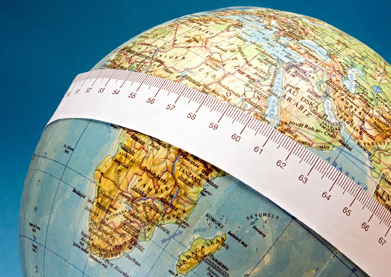Module 1
1. Module 1
Module 1 Introduction
Over 2000 years ago, Eratosthenes of Cyrene (c. 276 BCE–195 BCE) used trigonometry to estimate the diameter of Earth. Today’s accepted value is approximately 40 000 km. His value was between 39 690 km and 46 620 km—not a bad calculation from someone who was working without a calculator, satellite imagery, laser range-finder, or even algebraic symbols!

Hemera/Thinkstock
Trigonometry is the study of triangles, including the relationships between side lengths and angles. In previous math courses, your study was limited to right triangles (i.e., triangles that contain a 90° angle). In Mathematics 20-2, you will extend your skills to deal with oblique triangles (i.e., triangles that do not contain a 90° angle).
Although trigonometry is useful in many different areas, such as astronomy, architecture, and computer graphics, this module will focus on using trigonometry to measure distances and angles indirectly. Sometimes it is difficult, if not almost impossible, to measure a distance directly. Indirect measurement combined with trigonometry makes it easy to calculate these distances.
For instance, indirect measurement can be used to calculate the following:
- the height of a building
- long distances for map-making using a process called triangulation, which, in turn, uses trigonometry
Did You Know?
Although triangulation for map-making was used as long as 2500 years ago, it was also used as recently as the 1960s. Prior to the advent of the global positioning system (GPS) in 1973, one of the main techniques for determining distances in map-making was triangulation. For instance, triangulation was used to create an accurate map of Britain during the Principal Triangulation of Britain between 1783 and 1853 and again during the Retriangulation of Great Britain between 1936 and 1962.
In both cases, distances and angles were measured and trigonometry was used to fill in a detailed map of the country.

Hemera Technologies/Photos.com/Thinkstock
The height of the Calgary Tower (191 m) could be measured using a clinometer and trigonometry.
In this module you will investigate the following inquiry question:
- How can you solve triangle problems that do not involve right triangles?
To investigate this module question, you will focus on the following lessons and corresponding inquiry questions shown in the table below.
|
Lesson |
Title |
Lesson Inquiry Questions |
|
1 |
Working with Multiple Triangles |
How can you use multiple triangles to solve indirect measurement problems? |
|
2 |
The Sine Law |
Do the Pythagorean theorem and the primary trigonometric ratios (sine, cosine, and tangent) work when solving oblique triangle problems? |
|
What formulas can be used to solve for angles and sides in any triangle (including oblique triangles)? |
||
|
3 |
The Cosine Law |
What formulas can be used to solve for angles and sides in any triangle (including oblique triangles)? |
|
How do you determine when to use the sine law and when to use the cosine law? |
||
|
4 |
Working with Multiple Oblique Triangles |
How do you determine when to use the sine law and when to use the cosine law? |
Module 1 Project
At the end of this module, you will complete a project using a simplified form of triangulation to determine distances and angles to select the best route for a pipeline construction project. For specific instructions, refer to the Module 1 Project document.
Strategies for Success
You may find the following strategies useful to support your success in this module.
Strategy 1: Course Glossary
Recall from the course introduction that you will build your own version of a glossary in this course. As you encounter new terms in the lesson, you can add them to your Glossary Terms document. For a full description, refer to the Glossary Terms document in the Toolkit. If you have not already done so, you should save a copy of the Glossary Terms document to your course folder.
Strategy 2: Notes Organizer
A notes organizer is a tool for recording key concepts, terms, examples, or tips from each lesson in one place to refer to as you work through the course. Notes can be organized in a variety of formats. If you have not done so already, take a look at the Notes Organizer document for some ideas.
Strategy 3: Supplementary Resources

Hemera/Thinkstock
You will be referring to Chapter 3 (pages 127 to 171) of the Principles of Mathematics 11 textbook. Take time to flip through these textbook pages. Look at illustrations, margin features, and main titles to get a sense of the concepts you will be covering in this module.
There are also resources available on LearnAlberta.ca. Your teacher can provide you with a username and a password to access content on LearnAlberta.ca. An Internet search can also provide you with useful information. Just remember to consider the source of the information.
Are you ready to begin Module 1: Trigonometry? It all starts with Lesson 1, where you learn to apply the Pythagorean theorem and the primary trigonometric ratios (SOH CAH TOA) to problems involving multiple triangles.